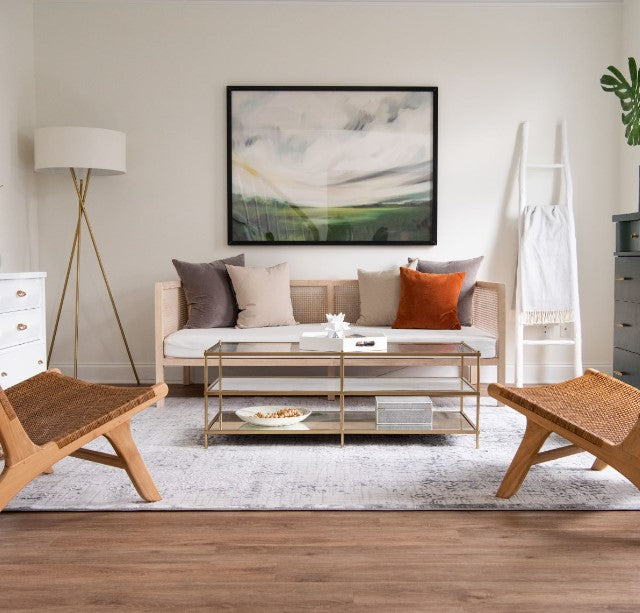Choosing the right area rug for your room can dramatically transform the look and feel of your space. An area rug adds warmth, color, and texture to a room, tying together all the elements of your décor. However, with so many options available in terms of size, material, color, and pattern, selecting the perfect rug can be a daunting task. This guide will help you navigate through the process of choosing the right area rug for your room by covering key considerations such as size, material, style, and placement.
1. Understanding the Purpose of Your Area Rug
Before you start shopping for an area rug, it's important to define its purpose in the room. Are you looking for something to anchor your furniture, add a pop of color, or simply provide warmth underfoot? Understanding the role you want the rug to play will help narrow down your choices.
-
Anchor the Room: If the rug is meant to anchor your furniture, especially in a living room or dining area, you'll need a size that accommodates all the major pieces of furniture. The rug should be large enough to create a cohesive look and define the space.
-
Add Color or Pattern: If your room’s color scheme is neutral or monochromatic, an area rug can introduce a vibrant color or bold pattern. Conversely, if your room already has a lot of color, you might opt for a rug with a more subdued palette.
-
Provide Comfort: In bedrooms or cozy living spaces, you might prioritize comfort. A plush, high-pile rug can add softness and warmth, making the room more inviting.
2. Choosing the Right Size
Selecting the correct rug size is crucial. A rug that's too small can make your room feel disjointed, while one that's too large might overwhelm the space. Here are some guidelines to help you choose the right size:
-
Living Room: The rug should be large enough to fit under the front legs of your sofa and chairs, ideally extending beyond the sides of the furniture by 6 to 12 inches. If you have a larger living space, consider a rug that fits all the furniture, including the back legs.
-
Dining Room: The rug should be large enough to fit under the table and chairs, even when the chairs are pulled out. A good rule of thumb is to add at least 24 inches to all sides of your dining table dimensions.
-
Bedroom: In a bedroom, you want a rug that extends at least 2 to 3 feet beyond the sides of your bed, allowing you to step onto a soft surface when you get out of bed. If you have a larger bed, such as a king size, consider placing a large rug underneath or smaller rugs on each side.
-
Hallways and Entryways: For narrow spaces like hallways, a runner rug that leaves a few inches of floor space on either side creates a balanced look. In entryways, choose a rug that leaves some space around the edges for a welcoming entry.
3. Selecting the Best Material
The material of your area rug impacts its durability, comfort, and maintenance needs. Here are some popular materials and their benefits:
-
Wool: Wool rugs are durable, soft, and naturally stain-resistant, making them a great choice for high-traffic areas. They also have good insulation properties, adding warmth to your room.
-
Cotton: Cotton rugs are lightweight, affordable, and easy to clean, but they may not be as durable as wool. They’re ideal for casual spaces or as smaller accent rugs.
-
Synthetic Fibers (Nylon, Polyester, Polypropylene): Synthetic rugs are often more affordable and resistant to stains and fading. They’re a good option for busy households, especially in areas prone to spills or heavy foot traffic.
-
Jute and Sisal: These natural fibers are eco-friendly and add a textured, organic feel to your room. However, they’re not as soft underfoot and can be harder to clean, so they’re best suited for low-traffic areas.
-
Silk: Silk rugs are luxurious and have a beautiful sheen, but they’re also delicate and expensive. They’re best used in low-traffic areas where they can be appreciated without the risk of damage.
4. Considering the Style and Design
The style of your area rug should complement the overall aesthetic of your room. Whether your décor is modern, traditional, or somewhere in between, there's a rug that will suit your style.
-
Modern and Contemporary: Rugs with bold colors, abstract patterns, or geometric designs work well in modern spaces. Look for clean lines and minimalistic patterns that align with the room's aesthetic.
-
Traditional: Persian, Oriental, and other classic rug designs with intricate patterns and rich colors are perfect for traditional or vintage-inspired interiors. These rugs add a sense of history and elegance to a room.
-
Transitional: Transitional rugs blend traditional and modern elements, making them versatile for a range of décor styles. They often feature more subdued patterns and color palettes.
-
Bohemian: If your style is more eclectic, a bohemian rug with vibrant colors, varied textures, and global-inspired patterns will enhance the laid-back, artistic vibe of the room.
-
Neutral: For a timeless look, neutral rugs in shades of beige, gray, or ivory can provide a subtle foundation that allows other elements in the room to stand out.
5. Evaluating the Rug’s Durability
When choosing an area rug, consider the amount of foot traffic the room will receive. High-traffic areas like hallways, living rooms, and kitchens require more durable rugs that can withstand daily wear and tear.
-
High Traffic: For areas with heavy foot traffic, opt for durable materials like wool, nylon, or polypropylene. These materials are resilient and can handle the constant use.
-
Low Traffic: In rooms with less foot traffic, such as bedrooms or formal dining rooms, you can choose more delicate materials like silk or jute, which may not hold up as well in busier spaces.
6. Placement and Layering
Proper placement of your area rug can enhance the room’s layout and create a more harmonious space. Here are some placement tips:
-
Centering the Rug: In most rooms, centering the rug under the main furniture grouping creates a balanced look. For example, in a living room, the rug should anchor the seating area.
-
Layering Rugs: Layering smaller rugs over larger ones is a stylish way to add texture and dimension to a room. This technique works well in larger spaces or when you want to introduce multiple patterns or colors.
-
Angle Placement: In some cases, placing the rug at an angle can add visual interest and break up the linearity of a room. This works particularly well in smaller or more unique spaces.
7. Maintenance and Care
To keep your area rug looking its best, regular maintenance is essential. Here’s how to care for your rug:
-
Vacuum Regularly: Regular vacuuming helps remove dirt and debris that can damage the fibers. For high-pile rugs, use a vacuum with adjustable height settings.
-
Spot Clean: Address spills and stains immediately to prevent permanent damage. Use a mild detergent or a rug-specific cleaner, and always test a small area first.
-
Rotate the Rug: Rotating your rug every few months helps distribute wear evenly, especially in high-traffic areas.
-
Professional Cleaning: Periodic professional cleaning is recommended for most rugs, especially wool and silk, to maintain their appearance and longevity.
Conclusion
Choosing the right area rug for your room involves more than just picking a color or pattern you like. It’s about finding the right size, material, and style that complements your décor and meets the practical needs of your space. By considering the purpose, size, material, style, durability, and placement, you can select an area rug that not only enhances the look of your room but also provides comfort and functionality. With the right rug, your space will feel complete, stylish, and welcoming.


